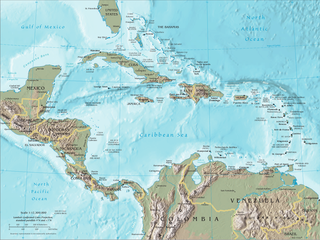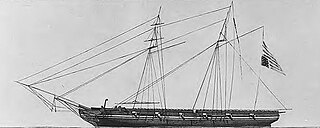Related Research Articles

Edward Teach, better known as Blackbeard, was an English pirate who operated around the West Indies and the eastern coast of Britain's North American colonies. Little is known about his early life, but he may have been a sailor on privateer ships during Queen Anne's War before he settled on the Bahamian island of New Providence, a base for Captain Benjamin Hornigold, whose crew Teach joined around 1716. Hornigold placed him in command of a sloop that he had captured, and the two engaged in numerous acts of piracy. Their numbers were boosted by the addition to their fleet of two more ships, one of which was commanded by Stede Bonnet, but Hornigold retired from piracy toward the end of 1717, taking two vessels with him.

The era of piracy in the Caribbean began in the 1500s and phased out in the 1830s after the navies of the nations of Western Europe and North America with colonies in the Caribbean began hunting and prosecuting pirates. The period during which pirates were most successful was from the 1650s to the 1730s. Piracy flourished in the Caribbean because of the existence of pirate seaports such as Port Royal in Jamaica, Tortuga in Haiti, and Nassau in the Bahamas. Piracy in the Caribbean was part of a larger historical phenomenon of piracy, as it existed close to major trade and exploration routes in almost all the five oceans.
Robert Culliford was a pirate from Cornwall who is best remembered for repeatedly checking the designs of Captain William Kidd.

Cape Henry is a cape on the Atlantic shore of Virginia located in the northeast corner of Virginia Beach. It is the southern boundary of the entrance to the long estuary of the Chesapeake Bay.

Edward England was an Irish pirate. The ships he sailed on included the Pearl and later the Fancy, for which England exchanged the Pearl in 1720. His flag was the classic Jolly Roger — almost exactly as the one "Black Sam" Bellamy used — with a human skull above two crossed bones on a black background. Like Bellamy, England was known for his kindness and compassion as a leader, unlike many other pirates of the time.

The Golden Age of Piracy is a common designation for the period between the 1650s and the 1730s, when maritime piracy was a significant factor in the histories of the North Atlantic and Indian Oceans.

Edward Low was a pirate of English origin during the latter days of the Golden Age of Piracy, in the early 18th century. Low was born into poverty in Westminster, London, and was a thief from an early age. He moved to Boston, Massachusetts, as a young man. His wife died in childbirth in late 1719. Two years later, he became a pirate, operating off the coasts of New England and the Azores, and in the Caribbean.

The Lynnhaven River is a tidal estuary located in the independent city of Virginia Beach, Virginia, in the United States, and flows into the Chesapeake Bay west of Cape Henry at Lynnhaven Inlet, beyond which is Lynnhaven Roads. It has a small, developed watershed covering 64 square miles (170 km2), terminating at Lynnhaven Bay. It was once famous along the East Coast of the United States for its oysters, which declined through pollution and runoff. It is now being restored by the Lynnhaven River Now restoration project based out of the Brock Environmental Center. A proposed comprehensive project for ecosystem restoration of the Lynnhaven River Basin is currently under consideration by the United States Congress.

Thomas Anstis was an early 18th-century pirate, who served under Captain Howell Davis and Captain Bartholomew Roberts, before setting up on his own account, raiding shipping on the eastern coast of the American colonies and in the Caribbean during what is often referred to as the "Golden Age of Piracy".
The Pirate Round was a sailing route followed by certain, mainly English, pirates, during the late 17th century and early 18th century. The course led from the western Atlantic, parallel to the Cape Route around the southern tip of Africa, stopping at Madagascar, then on to targets such as the coast of Yemen and India. The Pirate Round was briefly used again during the early 1720s. Pirates who followed the route are sometimes referred to as Roundsmen. The Pirate Round was largely co-extensive with the routes of the East India Company ships of Britain and other nations.

Charles Gibbs was the pseudonym of an American pirate, born James D. Jeffers. Jeffers was one of the last active pirates in the Caribbean during the early 19th century, and was among the last persons to be executed for piracy by the United States.
Captain John Coxon, sometimes referred to as John Coxen, was a late-seventeenth-century buccaneer who terrorized the Spanish Main. Coxon was one of the most famous of the Brethren of the Coast, a loose consortium of pirates and privateers. Coxon lived during the Buccaneering Age of Piracy.

The West Indies Anti-Piracy Operations were a series of military operations and engagements undertaken by the United States Navy against pirates in and around the Antilles. Between 1814 and 1825, the American West Indies Squadron hunted pirates on both sea and land, primarily around Cuba and Puerto Rico. After the capture of Roberto Cofresi in 1825, acts of piracy became rare, and the operation was considered a success, although limited occurrences went on until slightly after the start of the 20th century.
Richard Glover was a pirate and slave-trader active in the Caribbean and the Red Sea in the late 1690s.

The Flying Gang was an 18th-century group of pirates who established themselves in Nassau, New Providence in the Bahamas after the destruction of Port Royal in Jamaica. The gang consisted of the most notorious and cunning pirates of the time, and they terrorized and pillaged the Caribbean until the Royal Navy and infighting brought them to justice. They achieved great fame and wealth by raiding salvagers attempting to recover gold from the sunken Spanish treasure fleet. They established their own codes and governed themselves independent from any of the colonial powers of the time. Nassau was deemed the Republic of Pirates as it attracted many former privateers looking for work to its shores. The Governor of Bermuda stated that there were over 1,000 pirates in Nassau at that time and that they outnumbered the mere hundred inhabitants in the town.

Philip Lyne was a pirate known for his cruelty and his association with Francis Spriggs.
John James was a Welsh pirate active near Madagascar, Nassau, and the American east coast.
Mary Critchett was an English pirate and convict. She is best known for being one of only four confirmed female pirates from the Golden Age of Piracy, and the only one executed.
Jean Charpin was a French pirate and buccaneer active in the Caribbean and off the coast of Africa. He is best known for sailing alongside Jean-Baptiste du Casse as well as for his Articles, or “Pirate Code.”
Thomas Day was a pirate and privateer active off the American east coast. He is known for being one cause of increasing tensions between the Governors of Maryland and Pennsylvania.
References
- Earle, Peter. The Pirate Wars. New York: St. Martin's Press, 2005. ISBN 0-312-33579-2
- Peabody & Essex Museum. The American Neptune . Salem, Massachusetts: Peabody Museum of Salem, 1941.
- ↑ Harold Tom Wilkins (1937). Captain Kidd and His Skeleton Island: The Discovery of a Strange Secret Hidden for 266 Years. Liveright Publishing Corporation. p. 233.
- ↑ "Pirates in Virginia". www.virginiaplaces.org. Retrieved 21 June 2017.
- ↑ Donnelly, Mark P.; Diehl, Daniel (2012). Pirates of Virginia: Plunder and High Adventure on the Old Dominion Coastline. Mechanicsburg PA: Stackpole Books. pp. 57–67. ISBN 9780811745833 . Retrieved 23 June 2017.
- ↑ "The bloodiest pirate battle to hit these waters". Virginian-Pilot. Retrieved 21 June 2017.
- ↑ Erickson, Mark St. John. "A daring governor shows his mettle in a bloody April 29, 1700 pirate battle". dailypress.com. Archived from the original on 7 August 2017. Retrieved 21 June 2017.
